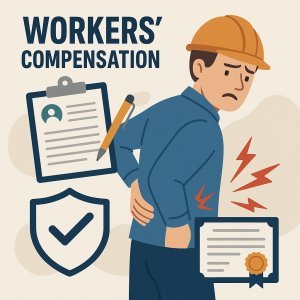
Workers Comp Premium Financing: Improve Cash Flow Without Penalties
August 11, 2025
Fraud Detection Tactics for Georgia Security Guard Employers
August 11, 2025As security technology rapidly evolves, the integration of drones and robotic patrol systems has become an increasingly common strategy for enhancing surveillance and response capabilities in various industries. While these advancements offer notable operational benefits,they also introduce new complexities in managing workplace risks and ensuring employee safety. For security guard professionals, understanding the nuances of workers’ compensation in the context of drone and robotic patrol integration is essential. This article explores the implications of these emerging technologies on workers’ compensation claims, risk management practices, and the broader landscape of security workforce protection.
Table of Contents
- Security Guard workers compensation Challenges in the Era of Drone and Robotic Patrols
- Assessing Liability and Risk Management for Automated Security Systems
- Best Practices for Integrating Drone and Robotic Patrols into Existing Workers Comp Frameworks
- Policy Recommendations for Ensuring Comprehensive Coverage and Compliance
- Q&A
- To Conclude
Security Guard Workers Compensation Challenges in the Era of Drone and Robotic Patrols
The integration of drones and robotic patrols in security services introduces unique challenges for workers’ compensation claims. Traditional compensable injuries, such as slips, trips, and falls, now coexist with complex scenarios involving technology-related risks. As a notable exmaple, security personnel might experience injuries when interacting with, controlling, or repairing autonomous devices, raising questions about liability and coverage scope. Additionally, the shift toward remote monitoring roles can blur the line between physical and mental health claims, emphasizing the need for clear policy definitions around work-from-home ergonomic injuries and stress-related illnesses linked to overseeing robotic systems.
Employers and insurers must also navigate emerging risks posed by technology malfunction and cybersecurity breaches that could directly or indirectly affect human workers’ safety. Below are key areas requiring attention to mitigate liability and streamline workers’ comp processes:
- Training & Certification: Ensuring security staff are properly trained to operate or coexist safely with drones and robots.
- Equipment Maintenance: Proactive upkeep to prevent malfunctions that could cause injuries.
- Clear Liability Frameworks: Defining obligation if autonomous systems contribute to workplace injuries.
- Mental Health Monitoring: Addressing psychological strain from managing advanced surveillance technologies.
| Risk Category | Potential Workers’ Comp Impact | Preventive Measure |
|---|---|---|
| Physical interaction | injuries from handling malfunctioning drones | Regular equipment safety inspections |
| Remote Monitoring | Ergonomic injuries, eye strain | Proper workstation setup and breaks |
| Cybersecurity Breach | Operational disruptions causing accidents | Robust IT security protocols |
| Mental Health | Stress, anxiety from tech overload | Employee support programs |
Assessing Liability and Risk Management for Automated Security Systems
Integrating advanced automated security systems such as drones and robotic patrol units into traditional security frameworks inevitably introduces new dimensions of liability. Organizations must carefully evaluate the potential hazards associated with software malfunctions, hardware failures, and cyber vulnerabilities that could compromise the safety of personnel and the public. Key considerations include:
- Operational Error Risks – Misinterpretation of commands or navigation errors by autonomous systems, increasing collision or injury risk.
- Cybersecurity threats – Exposure to hacking or data breaches that could disrupt security protocols or be exploited for malicious intent.
- Compliance Challenges – Adherence to evolving regulations concerning drone flights and robotic operations in public and private spaces.
risk management strategies must be tailored to these unique factors and incorporated within workers’ compensation frameworks to ensure adequate protection for security personnel involved in overseeing or collaborating with automated systems. To assist in this approach, the following highlights key liability categories and their impact on compensation coverage:
| Liability Category | potential Risk | Compensation Impact |
|---|---|---|
| Physical Injury | Collisions or accidents caused by automated units | direct compensation claims |
| System Malfunction | Failures leading to security breaches or workplace hazards | Liability for operational disruptions |
| Data Breaches | Exposure of sensitive information via compromised devices | Legal penalties and indemnity costs |
Best Practices for integrating Drone and Robotic Patrols into Existing Workers Comp frameworks
When adopting drone and robotic patrols within your security workforce, it is imperative to align operational protocols closely with existing workers’ compensation policies. This begins with thorough risk assessments tailored to the unique hazards posed by autonomous technologies. establishing clear guidelines on the roles and responsibilities of human supervisors versus automated systems helps clarify liability and minimizes ambiguous injury claims. Additionally, comprehensive training programs for personnel on safe drone operation and emergency response must be prioritized to reduce incidents and support streamlined claims processing.
Key practices include:
- Regular policy audits to incorporate evolving drone technology regulations
- documentation protocols that integrate automated patrol logs with incident reports
- Collaborative safety committees involving tech operators, management, and legal advisors
- Implementation of specialized coverage options addressing equipment malfunction injuries
| Component | Considerations | Impact on Workers’ Comp |
|---|---|---|
| Operator Training | Certification & ongoing skill progress | reduces incident rates, lowers claims |
| Equipment Maintenance | Routine checks & immediate repairs | Prevents malfunctions causing injury |
| Policy Integration | Combine drone risks with traditional coverage | Ensures comprehensive claim handling |
Policy Recommendations for Ensuring Comprehensive Coverage and Compliance
To effectively address the complexities introduced by drone and robotic patrols in security operations, it is imperative to implement a regulatory framework that mandates standardized workers’ compensation coverage inclusive of both human and robotic-related incidents. Policies shoudl require thorough risk assessments during integration phases, ensuring insurance providers explicitly cover scenarios involving collaboration between security guards and autonomous systems. Moreover, defining clear liability boundaries and incorporating advanced incident reporting protocols will empower both insurers and employers to manage claims accurately and reduce fraudulent cases.
Recommended measures include:
- Mandatory training certification for security personnel operating alongside or remotely controlling drones and robots.
- Regular audits of existing workers’ compensation policies to update coverage in line with emerging technological hazards.
- Incentivizing insurance carriers to develop customized risk pools that reflect the dynamic nature of combined human-robot workforce environments.
| Policy Focus | Implementation Strategy | Expected Outcome |
|---|---|---|
| Coverage Expansion | Legislated mandate for integrated tech risks | Comprehensive claim protection |
| Training Standards | Certification for personnel & operators | Reduced incident rates |
| Liability Clarity | Defined roles in mixed patrol environments | Streamlined claims processing |
Q&A
Q&A: Security Guard Workers’ Compensation for Drone & Robotic Patrol Integration
Q1: What is the relevance of workers’ compensation for security guards when integrating drones and robotic patrols?
A1: As security companies incorporate drones and robotic patrols to enhance surveillance, workers’ compensation remains essential to protect human security guards from job-related injuries. Even with automation, guards may face new risks during interactions with technology or while performing traditional duties alongside innovative tools, making comprehensive workers’ comp coverage critical.
Q2: How does drone and robotic patrol technology impact the risk profile for security guard injuries?
A2: The integration of drone and robotic patrol technology can both mitigate and introduce risks. Automation reduces the necessity for physical patrols in hazardous areas, lowering injury rates from environmental factors. Conversely, operating, maintaining, or troubleshooting this equipment may expose guards to new ergonomic or technical hazards, requiring updated risk assessments and tailored workers’ comp policies.
Q3: Are employers required to modify workers’ compensation policies when adopting drone and robotic patrols?
A3: Employers should review and potentially update their workers’ compensation policies to address the evolving workplace environment. while standard coverage generally includes injuries incurred on the job, novel risks associated with advanced surveillance technologies necessitate clear policy adjustments to encompass incidents involving drone operation, robotic system malfunctions, or hybrid patrol scenarios.
Q4: What specific injuries or incidents might workers’ compensation cover in drone and robotic patrol contexts?
A4: Workers’ compensation can cover a range of injuries, including physical trauma from interactions or collisions with robotics, repetitive strain injuries from operating controls, falls or accidents during maintenance routines, and stress-related conditions linked to adapting to complex technologies. Claims may also arise from incidents where technology failure leads to unsafe situations requiring human intervention.
Q5: How can security firms mitigate worker injury risks associated with drones and robotic patrols?
A5: Mitigation strategies include comprehensive training on the safe use of drones and robots, implementing strict operational protocols, conducting regular maintenance to prevent malfunctions, and fostering a safety-focused workplace culture. Employing ergonomic equipment and providing protective gear can further reduce injury risk, ensuring workers’ compensation claims remain manageable.
Q6: What role does insurance play in supporting security operations incorporating advanced patrol technologies?
A6: Insurance, including workers’ compensation and general liability, plays a pivotal role in managing financial risks associated with workplace injuries and technology-related incidents. Adequate insurance coverage helps security firms recover costs from employee injuries, equipment damage, and potential third-party claims, providing stability as they innovate their patrol methodologies.
Q7: Are there regulatory considerations impacting workers’ compensation for security guards working with drones and robots?
A7: Regulatory frameworks governing workers’ compensation may vary by jurisdiction but generally require employers to maintain coverage for all occupational injuries, including those involving new technologies. Firms should stay informed of evolving regulations related to drone operations, robotic safety standards, and employment law to ensure compliance and proper risk management.
Q8: How can security firms ensure compliance and maximize safety as they adopt drone and robotic patrol systems?
A8: Firms can conduct thorough risk assessments, engage with insurance providers to review policy adequacy, invest in regular employee training, and collaborate with technology suppliers to understand safety features and limitations. Additionally, documenting policies and incident reports rigorously supports compliance and continuous enhancement in worker safety.
This Q&A addresses key considerations for security companies integrating drones and robotic patrols, emphasizing the importance of workers’ compensation and proactive safety management to support a secure and compliant operational transition.
To Conclude
incorporating drone and robotic patrol technologies into security guard operations represents a significant advancement in the industry, enhancing efficiency and safety. However, as these innovations become more prevalent, understanding the nuances of workers’ compensation coverage is critical for employers and insurers alike. Ensuring comprehensive protection for security personnel working alongside-or in conjunction with-automated systems will mitigate risk and support workforce confidence. By proactively addressing these evolving dynamics, businesses can safeguard their assets and personnel while fostering a resilient, forward-looking security environment.
“This content was generated with the assistance of artificial intelligence. While we strive for accuracy, AI-generated content may not always reflect the most current information or professional advice. Users are encouraged to independently verify critical information and, where appropriate, consult with qualified professionals, lawyers, state statutes and regulations & NCCI rules & manuals before making decisions based on this content.







